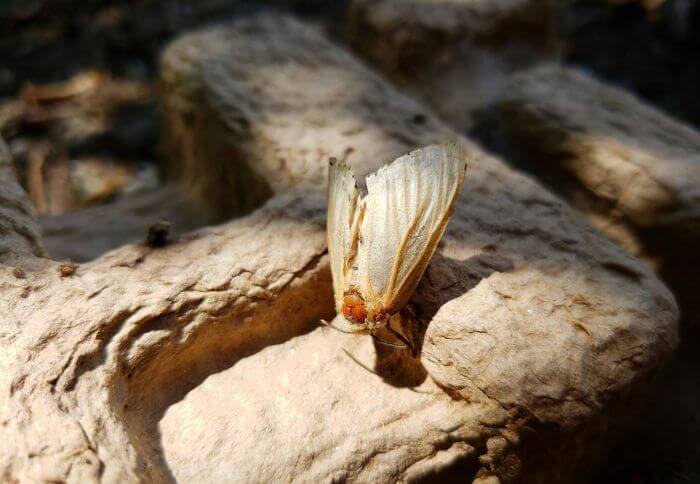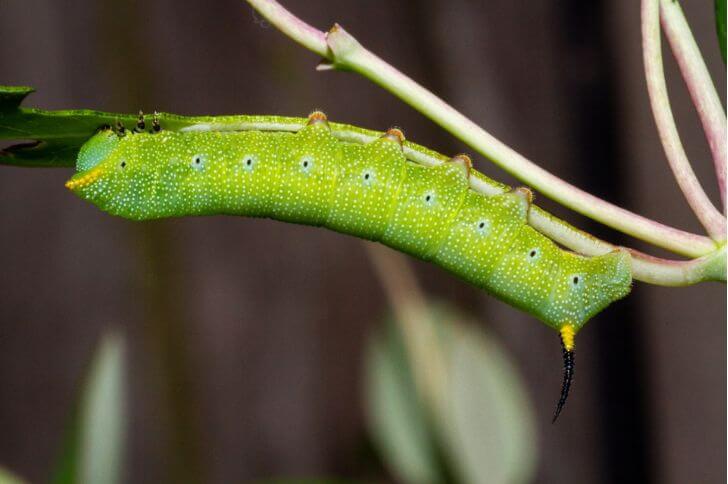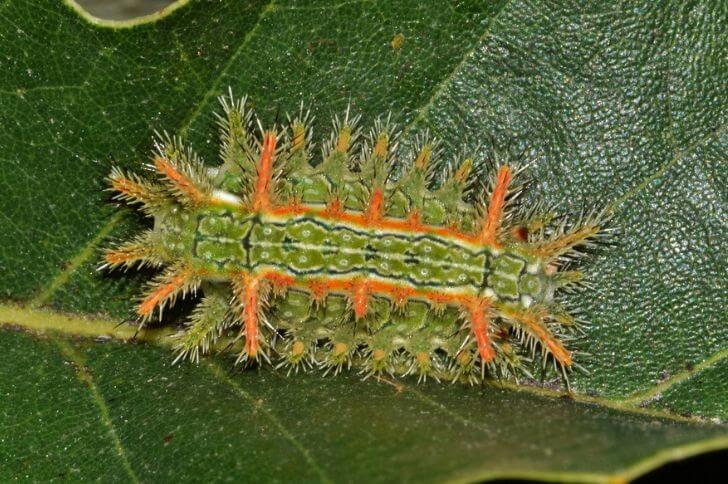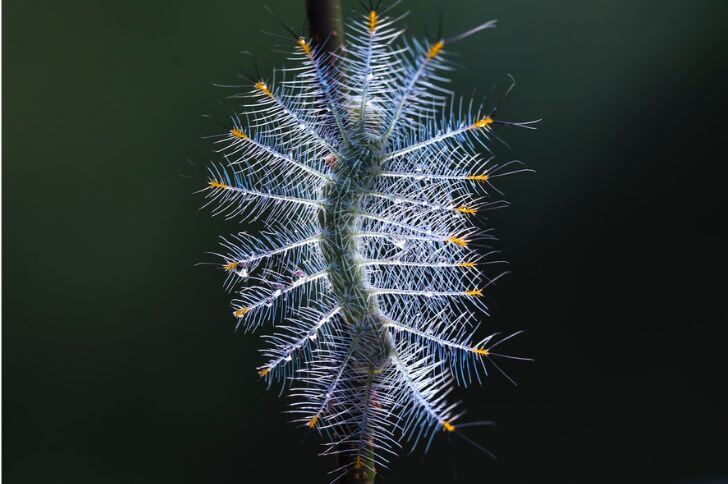Green Caterpillar with Horn (13 Species)
Green caterpillars with horns are a fascinating sight to behold in the world of insects. These unique creatures, adorned with vibrant green bodies and distinctively shaped protuberances, captivate our attention with their stunning beauty and intriguing behavior.
Found in various habitats across the globe, these caterpillars exhibit a wide range of characteristics that set them apart from their non-horned counterparts.
From enchanting horned hawkmoth caterpillars to elegant elephant hawk moth larvae, this article will explore the mesmerizing diversity of green caterpillars with horns, shedding light on their appearance, lifestyle, and remarkable adaptations that make them truly extraordinary creatures.
Green Caterpillar with Horn
1. Tomato Hornworm Caterpillar
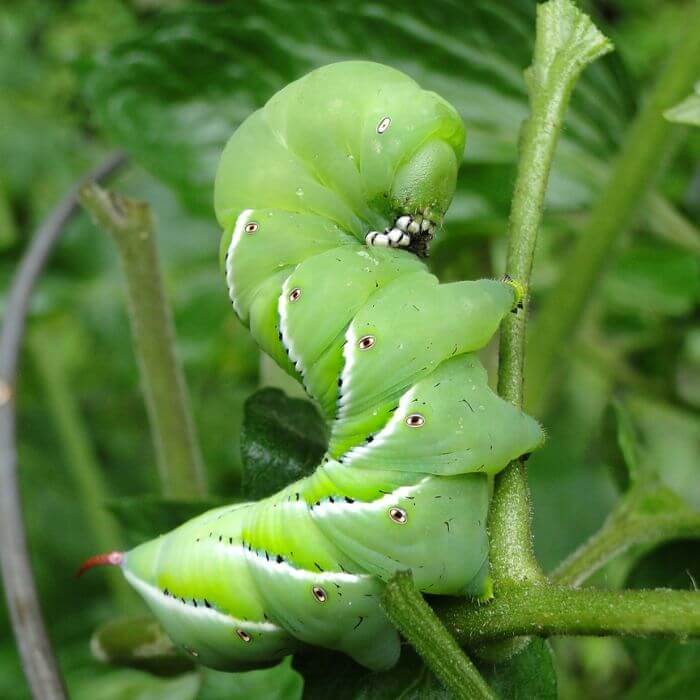
The tomato hornworm caterpillar is a fascinating creature that often captures the attention of gardeners and nature enthusiasts alike. With its bright green body and distinctive horn-like protrusion at the rear, it may seem formidable at first glance.
However, this hungry caterpillar plays an important role in the ecosystem by feeding on tomato plants and other members of the nightshade family.
In fact, their voracious appetite can quickly strip a plant of its leaves, causing concern for gardeners. But despite their destructive tendencies, these caterpillars serve as an essential food source for birds and other predators.
One of the most intriguing aspects of the tomato hornworm caterpillars is their ability to blend seamlessly with their surroundings. Their green coloration allows them to camouflage among leaves and foliage, making them almost invisible to unsuspecting eyes.
This helps them avoid detection by predators who may be hunting for a tasty meal. Additionally, they have evolved a mechanism called frass flicking, where they shoot out their pellet-like droppings to further confuse would-be attackers.
While many people may view these creatures as pests due to the damage they cause in gardens, taking a closer look reveals some interesting features that make them worthy of admiration.
2. Oleander Hawk Moth Caterpillar
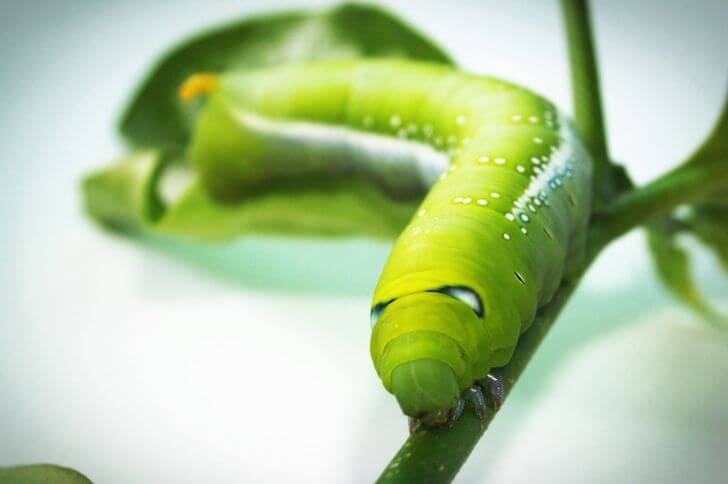
The discovery of the oleander hawk-moth caterpillar never fails to astonish nature enthusiasts. With bright green coloration and a distinctive horn-like projection on its rear end, this caterpillar stands out among its counterparts.
But what makes it truly fascinating is its ability to adapt to different environments by consuming a wide range of host plants.
One unique aspect of the oleander hawk moth caterpillar’s life cycle is its preference for toxic plant species like the oleander itself. While most organisms would steer clear of these dangerous plants, these caterpillars have developed a remarkable adaptation that allows them to not only survive but thrive on such toxicity.
Through their consumption of toxic foliage, they accumulate poisonous compounds that serve as an effective defense mechanism against predators.
Another captivating feature of this remarkable creature is its transformation into a pupa known as the chrysalis stage.
During this time, the once vibrant green caterpillar changes into a dull brown casing that camouflages seamlessly with tree bark or other surfaces in their surroundings.
This incredible transformation serves as a reminder that appearances can be deceiving, allowing these moths-in-waiting to blend in and protect themselves while undergoing their metamorphosis.
3. White-lined Sphinx Caterpillar

Known for its striking appearance and unique features, the white-lined sphinx caterpillar is an intriguing creature that will leave you in awe. With a bright green body and distinctive white stripes running along its sides, this green caterpillar with horn stands out from the crowd.
But what truly sets it apart is the horn located on its rear end, which adds another layer of intrigue to this already captivating insect.
Just like humans have fingerprints, each white-lined sphinx caterpillar has a distinct pattern of dots on its sides, making them easily distinguishable from one another.
This intricate design not only aids researchers in identifying individuals but also serves as a defense mechanism against predators who might mistake them for something less palatable.
The horn on their backs acts as an additional deterrent to unwanted attention, warning potential threats that they are not to be messed with.
Although their vibrant appearance may attract admiration, it’s important to remember that these caterpillars are herbivores with a keen appetite for plants.
Eating large quantities of leaves during their developmental stage allows them to grow quickly into fully formed adults ready for metamorphosis. So next time you spot a white-lined sphinx caterpillar munching away on foliage, admire its beauty but also respect its role in nature’s delicate balance.
Related Read: Check different types of fuzzy green caterpillars
4. Tobacco Hornworm Caterpillar
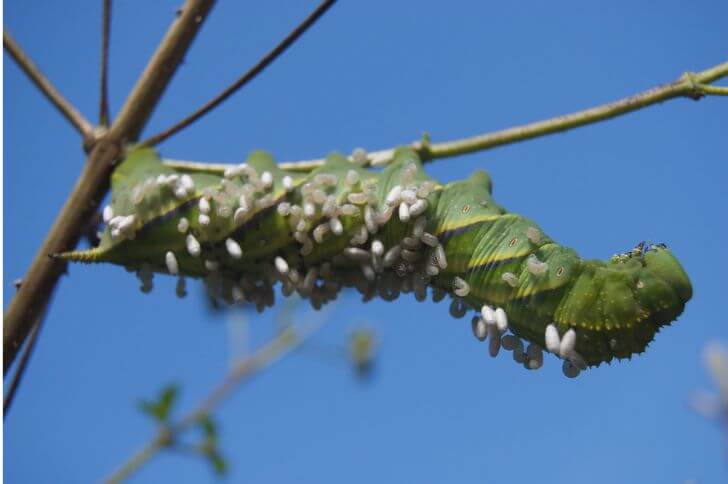
The Tobacco Hornworm Caterpillar may not look like much at first glance, but don’t let its unassuming appearance fool you. This green caterpillar with a horn is a true powerhouse of nature.
Sporting vibrant green coloration, it camouflages seamlessly among the leaves of tobacco plants, making it hard to spot for predators. But what truly sets this creature apart is its incredible appetite.
Consuming up to ten times its own body weight in foliage every day, the tobacco hornworm caterpillar can strip a plant bare in no time.
While their voracious appetite may make them unpopular among gardeners and farmers, these caterpillars have an important role to play in the ecosystem.
As they munch their way through leaf after leaf, they inadvertently help to prune and shape the plants they infest. In fact, their feeding habits are believed to trigger certain defense mechanisms within tobacco plants that ultimately enhance their overall growth and resilience against pests.
Despite being small and seemingly insignificant creatures, tobacco hornworm caterpillars offer us a valuable lesson in understanding the intricate balance of nature.
By studying them closely and appreciating their role within our ecosystems, we can gain a better appreciation for how all living organisms are interconnected and rely on each other’s presence for survival and growth.
5. Dragon-Headed Caterpillar

The dragon-headed caterpillar, also known as the Achemon sphinx, is a creature that captivates both nature lovers and insect enthusiasts alike.
Its name derives from the unique horn-like structure on its head, resembling that of a fearsome mythical dragon. And there’s more…
One remarkable aspect of the dragon-headed caterpillar is its ability to mimic dried leaves as a form of camouflage.
The brownish-green coloration and intricate patterns on its body help it blend in perfectly with the surrounding foliage, making it virtually invisible to predators. This adaptation not only aids in self-defense but also allows these caterpillars to ambush unsuspecting prey.
Another fascinating trait exhibited by these enchanting creatures is their peculiar behavior when threatened. When faced with danger or disturbance, dragon-headed caterpillars display an interesting defense mechanism known as startling discharges.
They emit loud sounds by forcefully expelling air through specialized organs called spiracles. This startling behavior aims to intimidate predators and protect this extraordinary species from harm.
6. Rustic Sphinx Caterpillar
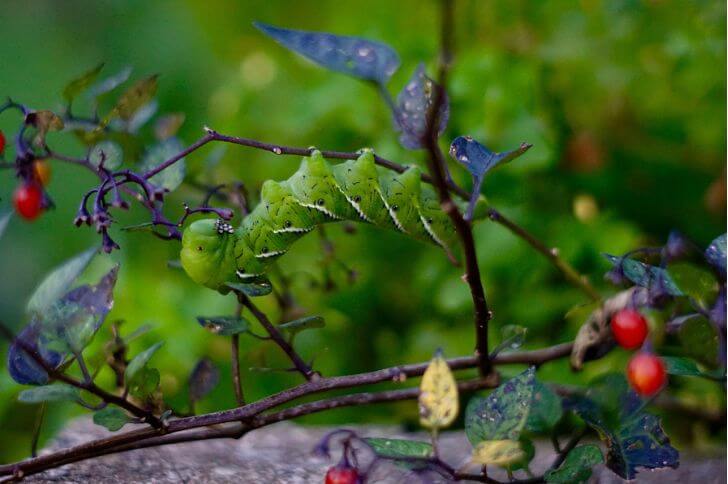
With its gorgeous green color and distinctive horn-like appendage on its rear end, the rustic sphinx caterpillar stands out among its counterparts in the insect kingdom. However, what sets it apart goes beyond its appearance.
If you enjoy watching insects transform, you’ll enjoy this green caterpillar’s ability to transform itself into a completely different form as it grows. Like other caterpillars, it undergoes metamorphosis to become a butterfly or moth.
But what makes this species unique is that during this transition, it sheds its old skin multiple times before emerging as a beautiful-winged insect. This process symbolizes not only physical growth but also spiritual transformation and renewal.
Another captivating aspect of these caterpillars is their symbiotic relationship with certain plants. They are often found curled up on leaves of specific host plants such as wild cherry trees or grapevines.
By feeding on these plants, these green caterpillars with horns unwittingly protect them from being over-consumed by other herbivores like deer or rabbits. In return for their protection services, they receive sustenance and safety within their leafy homes – a perfect example of nature’s interconnectedness and balance.
7. Hickory Horned Devil Caterpillar

The Hickory Horned Devil Caterpillar is a creature that demands attention with its unique appearance.
Its vibrant green color and intimidating horns are enough to make anyone give it a second glance. But what makes this caterpillar truly fascinating is its size. Measuring up to six inches long, it is one of the largest caterpillars in North America.
Contrary to its menacing appearance, the Hickory Horned Devil Caterpillar is harmless to humans. It may look like an alien creature, but it poses no threat apart from possibly startling unsuspecting passersby. In fact, this caterpillar has an important role to play in nature.
Preying on the leaves of trees such as hickory and walnut, it helps control their growth and maintain balance in ecosystems.
Observing a Hickory Horned Devil Caterpillar can be a remarkable experience for nature enthusiasts. From its astonishing size to its intricate patterns and spikes, every aspect of this creature speaks volumes about the wonders of evolution.
8. One-Eyed Sphinx (Smerinthus Ophthalmica) Caterpillar

source:beware_of_bog
One unique feature of the smerinthus ophthalmica caterpillar is the presence of a horn-like appendage on its back end. While many people might associate horns with aggression or defense mechanisms, this horn actually serves a different purpose for this particular caterpillar.
It acts as a deterrent against predators by radiating foul-smelling chemicals when threatened. This impressive adaptation helps to keep the caterpillar safe from potential harm.
As if the horn isn’t intriguing enough, the behavior of Smerinthus ophthalmica caterpillars is equally fascinating. Contrary to what one might expect, these green caterpillars with horns are typically solitary creatures that prefer to live in isolation rather than forming groups like some other species.
They are also known to be voracious eaters and can consume large amounts of leaves within a short period of time. Watching them feed can be both mesmerizing and awe-inspiring, as they effortlessly devour foliage with their strong jaws.
9. Bee Robber Caterpillar (Acherontia styx)

With its green hued body and distinct horn-like projection on its dorsal side, this caterpillar stands out from the rest. But its appearance is just the beginning of what makes it so captivating.
Underneath that striking exterior lies an arsenal of defense mechanisms that enable it to survive in its environment.
When threatened, this caterpillar can inflate itself by forcefully pumping air into sacs within its body, making it appear larger and more intimidating to potential predators.
Additionally, the horn on its back has a hidden secret – when touched or disturbed, it releases a foul-smelling substance that deters many predators from making a meal out of this intriguing little creature.
10. Rosy Maple Caterpillar
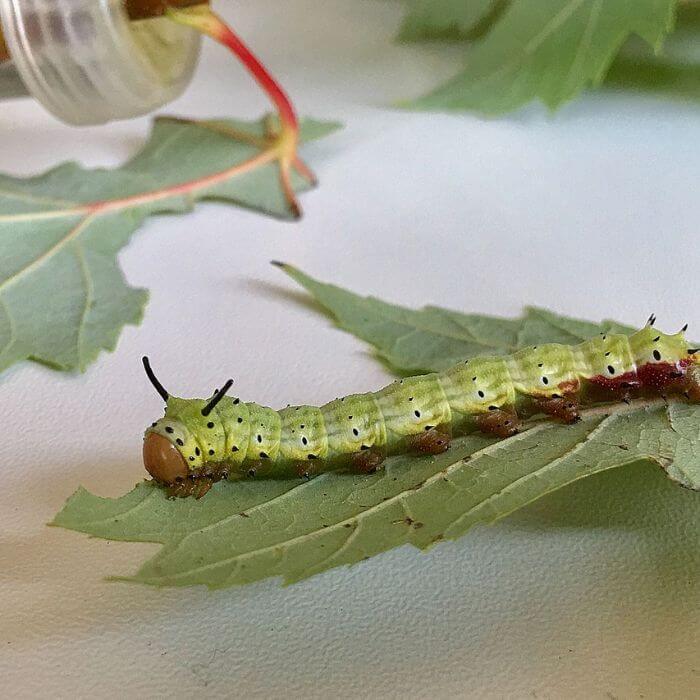
source:brendalsattler
The Rosy Maple caterpillar, scientifically called dryocampa rubicunda, is a curious creature that often goes unnoticed in the vast world of insects. However, this green caterpillar with its unique horn-like structures on its rear end is anything but ordinary.
Found in North America and inhabiting primarily maple trees, this little critter boasts vibrant colors of green and orange, making it hard to miss once you know what to look for.
One fascinating aspect about the Rosy Maple caterpillar is its ability to change appearance as it grows. When it first emerges from its eggs, it appears as a tiny black creature with spiky hairs.
As it grows older and sheds its skin multiple times, the dark markings start to blend in with the bright green coloration until they almost disappear completely. This incredible transformation not only helps camouflage them among the leaves but also offers protection against potential predators.
What truly sets apart the rosy Maple caterpillar is its behavior during molting or shedding its exoskeleton. Unlike many other species of caterpillars that seclude themselves during this process, these fascinating creatures form communal gatherings before molting together simultaneously.
They create a cozy space by weaving silk threads around their bodies and stay intertwined until their new skins harden. This peculiar social behavior adds an extra level of intrigue to an already captivating creature.
11. Hummingbird Clearwing Moth Caterpillar
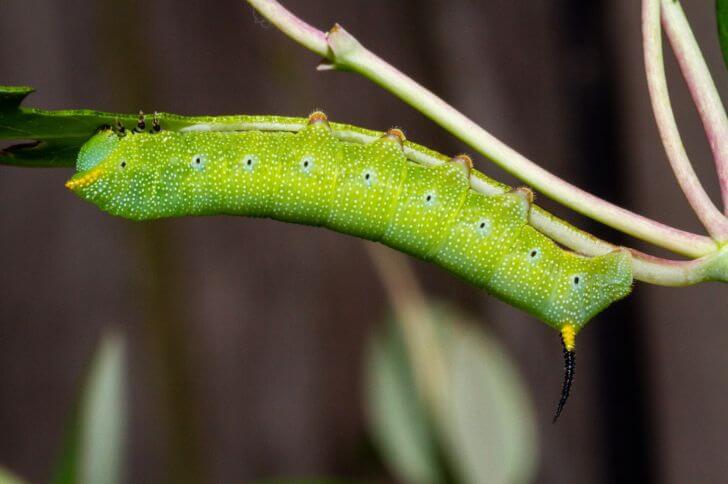
The hummingbird clearwing moth caterpillar, with its vibrant green color and distinctive horn-like appendage, is a mesmerizing creature that captivates the attention of anyone lucky enough to spot it.
This unique caterpillar belongs to the family Sphingidae, also known as sphinx moths or hawk moths. Unlike the typical image of a chubby caterpillar inching along on multiple legs, the hummingbird clearwing moth caterpillar is slender and elongated, resembling a tiny serpent in its movements.
Also, as a nature lover you’ll enjoy its ability to mimic a completely unrelated species – a bumblebee. As it moves from flower to flower searching for nectar, the hummingbird clearwing moth caterpillar stands out amongst other insects by adopting the appearance of an innocent bumblebee.
The combination of its yellow stripes and buzzing flight pattern successfully fool predators into believing they are dealing with an entirely different creature.
This clever act serves as both camouflage and self-defense, allowing this amazing caterpillar to go about its business undisturbed by potential threats.
Despite their delicate appearance, these astonishing creatures have developed an array of ingenious strategies that enable them to thrive in their natural habitat.
Their presence not only adds beauty and diversity to our surroundings but also reminds us of nature’s endless capacity for ingenuity and adaptation.
12. Eyed Hawk-Moth Caterpillar (Smerinthus ocellatus)
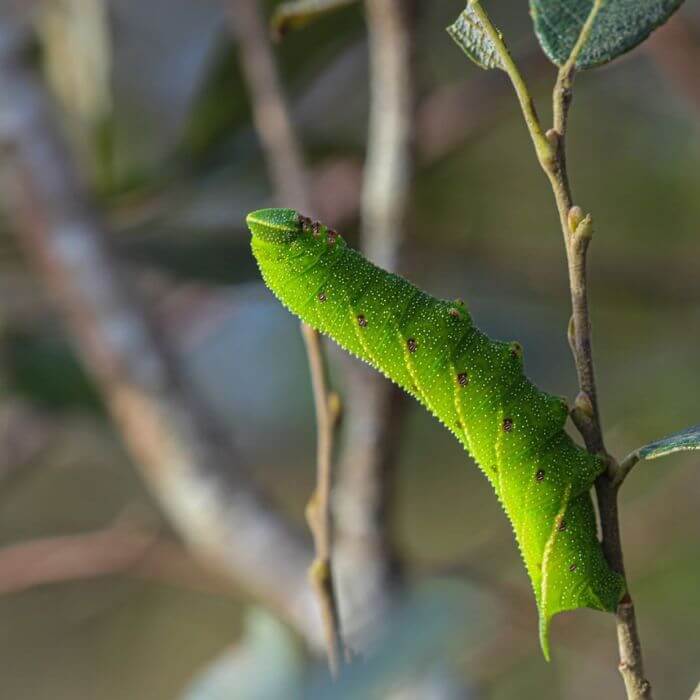
source: simon
Nestled among the leaves, blending in seamlessly with its surroundings, is the fascinating eyed hawk moth caterpillar. With its vibrant green hue and distinctive horn at the tail end, this caterpillar immediately catches the eye of any nature enthusiast lucky enough to stumble upon it. But there’s more to this creature than just its appearance.
One of the most intriguing features of the Smerinthus ocellatus caterpillar is its ability to mimic a snake when threatened. When disturbed or threatened by a predator, such as a bird or lizard, it rears up and contorts itself in a way that resembles a snake’s head.
This clever defense mechanism gives potential attackers pause, making them think twice before attempting to strike at what they believe to be a dangerous reptile.
But beyond its deceptive tactics lies another captivating aspect of this larval stage: metamorphosis. After weeks of munching on foliage and growing larger by the day, this green caterpillar will eventually transition into an entirely different form – that of a majestic moth known as the Eyed Hawkmoth.
From humble beginnings as a tiny egg laid on tree branches or stems, this remarkable creature goes through several stages before emerging as an adult capable of flight.
13. Tailed Jay Caterpillar (Graphium agamemnon)

source: apangestika
The Graphium agamemnon caterpillar may appear inconspicuous at first glance, but its striking features and behavior make it a fascinating creature to observe. This species of green caterpillar with a horn is commonly found in Southeast Asia and has caught the attention of many nature enthusiasts.
One of the most intriguing aspects of these caterpillars is their unique defense mechanism – when threatened, they inflate their bright red osmeterium, resembling a snake’s tongue.
This sudden transformation sends a clear message to predators that the Graphium agamemnon caterpillar is not to be messed with.
Another remarkable characteristic of these caterpillars is their ability to camouflage effectively in their surroundings. Their vibrant green color enables them to blend seamlessly into the foliage, making them almost invisible to potential threats. It is mesmerizing how nature has crafted such intricate adaptations for survival.
However, what truly captures the imagination are the small silver spots on each segment of their body which shimmer like tiny stars during sunlight or if viewed from specific angles. These subtle details add an unexpected charm to these already captivating creatures.
Final Thoughts
Green horned caterpillars may seem strange and fascinating, but they serve an important purpose in the ecosystem. Their unique appearance and defensive behavior help them survive and thrive in their natural habitats.
While they may be a cause for concern for gardeners and farmers due to their appetite for plants, it is important to remember that they are part of a delicate balance in nature.
By understanding and appreciating these creatures, we can better appreciate the diversity of life on our planet. So next time you come across a green caterpillar with horn, take a moment to observe its beauty and marvel at the wonders of nature.
source:
https://en.wikipedia.org/wiki/Manduca_quinquemaculata
Passionate animal photographer with an unwavering love for capturing the essence and beauty of our furry friends.
With over five years of experience in the field, I have developed a unique ability to connect with animals on a deeper level, allowing me to create stunning and captivating images that truly reflect their personality.
Let’s collaborate to capture unforgettable moments that celebrate the unique bond between humans and animals!
